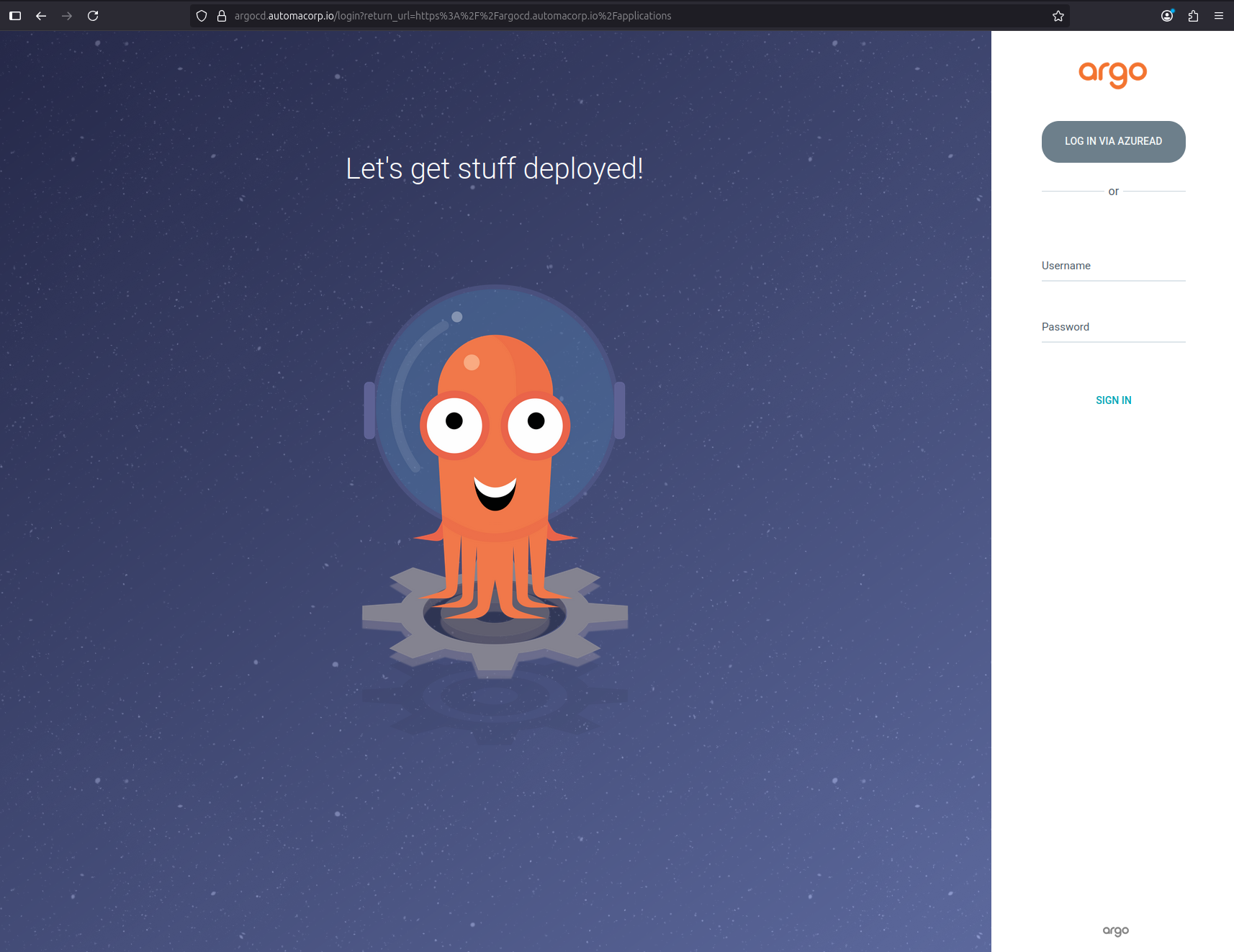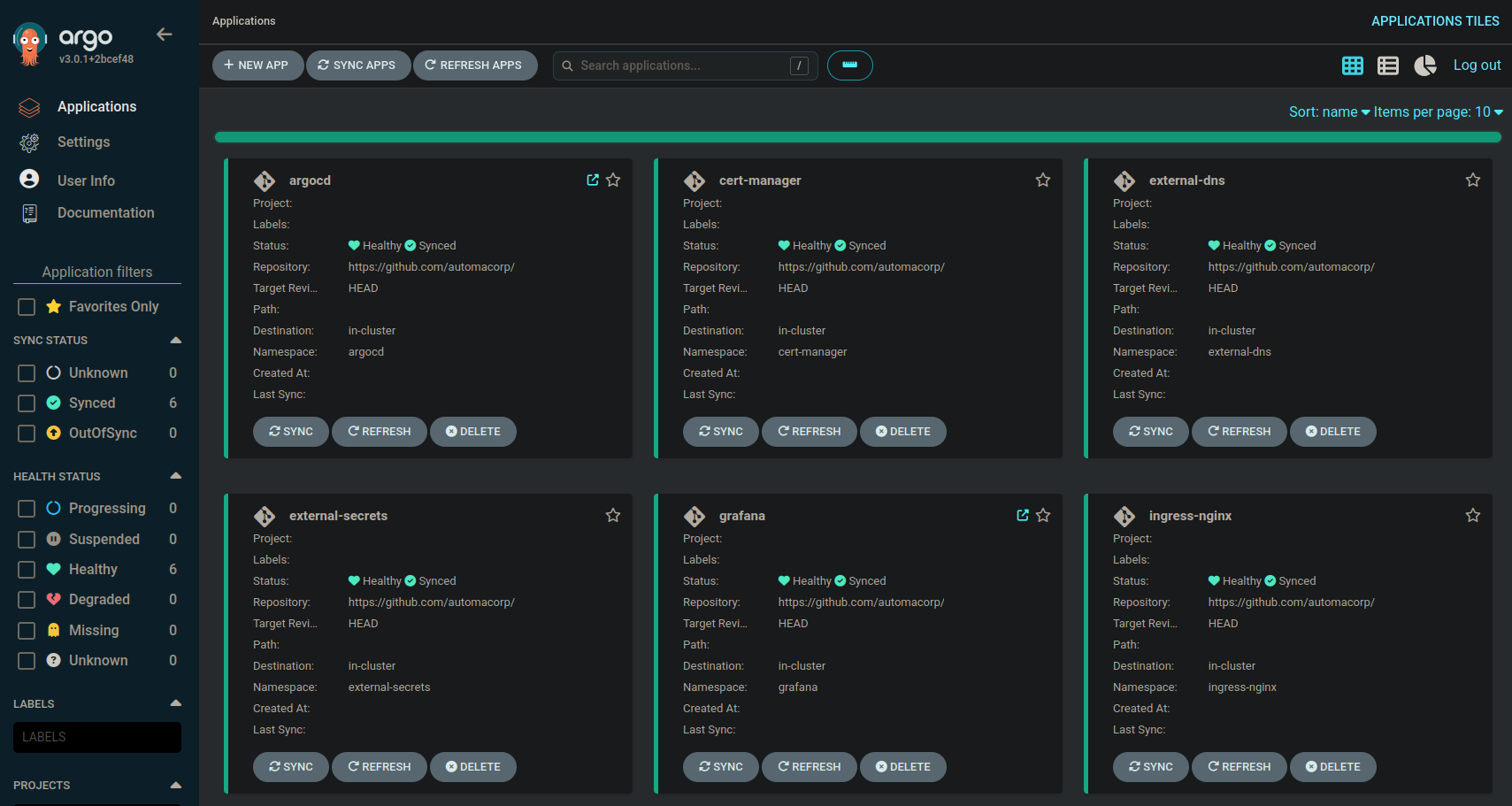ArgoCD provides a declarative, GitOps continuous reconciliation solution for Kubernetes.
By bootstrapping ArgoCD with GitHub Actions, you can automate the installation and configuration of ArgoCD on your Azure Kubernetes Service (AKS) clusters.
In this post, I’ll walk through setting up a GitHub App for ArgoCD, configuring repository secrets and environment variables, creating the GitHub Actions workflow, and enabling Microsoft Entra ID SSO via OpenID Connect (OIDC).
Prerequisites
Before we begin, ensure you have:
- An existing Azure tenant and subscription
- A Landing Zone in Azure with managed identities and GitHub federation
- An Azure Kubernetes Service cluster in that Landing Zone (e.g.
d-automacorp-aksin Resource Groupd-automacorp-rg) - A subscription‑vending process already wired to your GitHub repo
- A GitHub Organization (e.g.
AutomaCorp) - A GitHub repository (
automacorp/lz-automacorp) for deployments and ArgoCD manifests
1. Install GitHub App for ArgoCD
First, create a GitHub App to allow ArgoCD to read your repo contents securely.
- Navigate to https://github.com/organizations/AutomaCorp/settings/apps and click New GitHub App.
- Name:
argocd-management-app - Homepage URL:
https://github.com/AutomaCorp - Description (Optional):
Authentication between ArgoCD and GitHub - Leave Callback URL and Setup URL & Redirect blank.
- Webhook events: Uncheck Active (we don’t need webhooks).
- Permissions:
- Repository → Contents: Read-only
- Repository → Metadata: Read-only
- All other permissions: No access
- Where to install: Only on this account (AutomaCorp).
- Click Create GitHub App.
- After creation, click Install App → Only select repositories → choose
automacorp/lz-automacorp→ Install. - Under Private keys, click Generate a private key. Save the downloaded
key.pem. - Back in Install App, confirm the app is installed on the
automacorp/lz-automacorprepo. - Note the App ID and Installation ID for later.
2. Add Secrets to the GitHub Repository
Store the App credentials as repository secrets so that GitHub Actions can authenticate to GitHub.
gh auth login
gh secret set ARGOCD_APP_ID \
--body 'YOUR_APP_ID' \
--repo automacorp/lz-automacorp
gh secret set ARGOCD_APP_PRIVATE_KEY \
--body "$(cat key.pem)" \
--repo automacorp/lz-automacorp
gh secret set ARGOCD_APP_INSTALLATION_ID \
--body 'YOUR_INSTALLATION_ID' \
--repo automacorp/lz-automacorp3. Configure Environment Variables for the “Manage ArgoCD” Workflow
Define runtime variables per environment to target your AKS cluster and resource group.
gh variable set CLIENT_ID \
--body 'YOUR_CLIENT_ID' \
--repo automacorp/lz-automacorp \
--env dev
gh variable set RESOURCE_GROUP \
--body 'd-automacorp-rg' \
--repo automacorp/lz-automacorp \
--env dev
gh variable set CLUSTER_NAME \
--body 'd-automacorp-aks' \
--repo automacorp/lz-automacorp \
--env dev4. Add the "Manage ArgoCD" GitHub Actions Workflow
Create .github/workflows/manage-argocd.yml in your repository:
name: Manage ArgoCD
on:
schedule:
- cron: '0 0 * * *'
workflow_dispatch: {}
permissions:
id-token: write
contents: read
jobs:
manage-argocd:
environment: dev
runs-on: ubuntu-latest
env:
ARGOCD_REPO_URL: ${{ github.server_url }}/${{ github.repository }}.git
steps:
- name: Checkout code
uses: actions/checkout@v3
- name: Azure Login
uses: azure/login@v2
with:
client-id: ${{ vars.CLIENT_ID }}
tenant-id: ${{ vars.TENANT_ID }}
subscription-id: ${{ vars.SUBSCRIPTION_ID }}
- name: Setup kubectl
uses: azure/setup-kubectl@v3
- name: Setup kubelogin for AAD auth
uses: azure/use-kubelogin@v1
with:
kubelogin-version: 'v0.2.8'
- name: Set AKS kubectl context
uses: azure/aks-set-context@v2
with:
resource-group: ${{ vars.RESOURCE_GROUP }}
cluster-name: ${{ vars.CLUSTER_NAME }}
subscription: ${{ vars.SUBSCRIPTION_ID }}
use-kubelogin: true
- name: Convert kubeconfig for kubelogin
run: kubelogin convert-kubeconfig -l azurecli
- name: Add & update Argo Helm repo
run: |
helm repo add argo https://argoproj.github.io/argo-helm || true
helm repo update
- name: Detect existing ArgoCD release
id: detect
run: |
installed=$(helm list -n argocd --filter '^argocd$' -q)
echo "installed=$installed" >> $GITHUB_OUTPUT
- name: Bootstrap ArgoCD if missing
if: ${{ steps.detect.outputs.installed == '' }}
run: |
echo "→ ArgoCD not found → bootstrapping"
helm install argocd argo/argo-cd \
--namespace argocd \
--create-namespace \
-f argocd/manifests/values.yml
echo "→ waiting for server pod"
kubectl wait \
--namespace argocd \
--for=condition=ready pod \
--selector=app.kubernetes.io/name=argocd-server \
--timeout=120s
echo "→ install ArgoCD CLI"
curl -sSL https://github.com/argoproj/argo-cd/releases/latest/download/argocd-linux-amd64 \
-o /tmp/argocd
sudo install -m 755 /tmp/argocd /usr/local/bin/argocd
echo "→ determining Argo CD server address"
ARGO_HOST=$(kubectl get svc argocd-server -n argocd \
-o jsonpath='{.status.loadBalancer.ingress[0].ip}')
echo "→ ARGO_HOST=$ARGO_HOST"
echo "→ login to ArgoCD"
max_attempts=5
attempt_num=1
until argocd login $ARGO_HOST \
--username admin \
--password "$(kubectl -n argocd get secret argocd-initial-admin-secret -o jsonpath='{.data.password}' | base64 -d)" \
--insecure; do
echo " → login failed (attempt $attempt_num/$max_attempts), retrying in 5s…"
if [ "$attempt_num" -ge "$max_attempts" ]; then
echo " → login failed after $max_attempts attempts, aborting"
exit 1
fi
attempt_num=$((attempt_num + 1))
sleep 5
done
echo "→ add GitHub repo & apply projects"
printf '%s\n' "${{ secrets.ARGOCD_APP_PRIVATE_KEY }}" > key.pem
argocd repo add "$ARGOCD_REPO_URL" \
--github-app-id ${{ secrets.ARGOCD_APP_ID }} \
--github-app-installation-id ${{ secrets.ARGOCD_APP_INSTALLATION_ID }} \
--github-app-private-key-path ./key.pem
kubectl apply -f argocd/projects/
- name: Skip bootstrap if already installed
if: ${{ steps.detect.outputs.installed != '' }}
run: echo "→ ArgoCD already installed; skipping"Remember to create and populate your ArgoCD helm values file (argocd/manifests/values.yml) and projects folder (argocd/projects/).
5. Enable Microsoft Entra ID SSO with ArgoCD
To secure ArgoCD’s UI with Entra ID, register an Entra ID application and federate AKS OIDC.
5.1 Create the Entra ID App
az ad app create \
--display-name 'ArgoCD-OIDC' \
--web-redirect-uris 'https://argocd.automacorp.com/auth/callback' \
--sign-in-audience AzureADMyOrg \
--query '{appId: appId, objectId: id}' \
-o json5.2 Retrieve the AKS OIDC Issuer URL
az aks show \
--resource-group d-automacorp-rg \
--name d-automacorp-aks \
--query 'oidcIssuerProfile.issuerUrl' \
--output tsv5.3 Federate the ArgoCD Service account
az ad app federated-credential create \
--id 'objectId' \
--parameters '{
"name": "argocd-federation",
"issuer": "'aks-oidc-issuer-url'",
"subject": "system:serviceaccount:argocd:argocd-server",
"audiences": ["api://AzureADTokenExchange"]
}'5.4 Grant Microsoft Graph Permissions
az ad app permission add \
--id 'objectId' \
--api 00000003-0000-0000-c000-000000000000 \
--api-permissions e1fe6dd8-ba31-4d61-89e7-88639da4683d=Scope
az ad app permission grant \
--id 'objectId' \
--api 00000003-0000-0000-c000-000000000000 \
--scope User.Read
az ad app permission admin-consent \
--id 'objectId'5.5 Configure Security Groups for ArgoCD Roles
az ad group create \
--display-name 'ArgoCD-Admins' \
--mail-nickname 'argocd-admins'
az ad group member add \
--group 'ArgoCD-Admins' \
--member-id 'userObjectId'
az ad app update \
--id 'objectId' \
--set groupMembershipClaims=SecurityGroupIn your ArgoCD Helm values.yml, set oidc.config.clientID to the appId, and map the ArgoCD-Admins group to the admin role.
Populate your argocd/projects/ folder with AppProject, Application/ApplicationSet-manifests and run the workflow.
You can now log in with Entra ID in the ArgoCD portal:

Your apps should now appear automagically:
